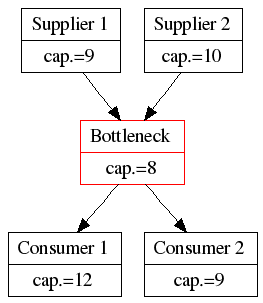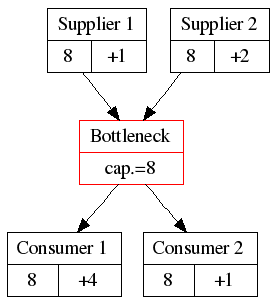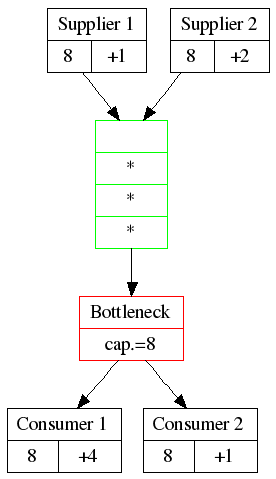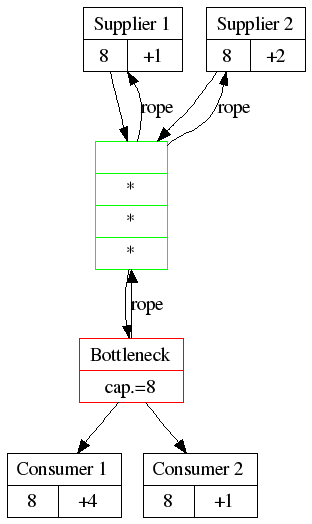If you believe the Theory of Constraints, you know a few things:
- the throughput of your system is determined by the throughput of your bottleneck
- you should keep the bottleneck working at 100%
- you should keep the non-bottlenecks working at less than 100%, so that they don’t generate wasteful work-in-progress or are unable to cope with fluctuations.
How do the non-bottlenecks know how fast they should work, without having a global coordination? By using the “Drum-Buffer-Rope” technique.
The system

The Drum
The bottleneck determines the speed at which the system works. This bottleneck can produce 8 items per unit of time. Therefore the bottleneck acts as a drum, beating the rhythm that the whole system should follow, like a drummer on a galley slave or the drummer of a marching band. The system has a rhythm of 8, so all participants in the system should follow the rhythm. This is one way to Level out the load. In Lean Thinking, this is called the “Takt Time”.
So, now we have everybody working at 8 items per unit of time.

The Buffer
But what if supplier 1 or 2 can’t produce exactly 8 items? The bottleneck will be starved and we lose precious throughput. That can’t be allowed to happen. Therefore, put a buffer of raw material in front of the bottleneck, so that it never has to wait.

The Rope
Supplier 1 and 2 won’t always be perfectly in lockstep with the Bottleneck. We don’t want the buffer to become too big or too full, because then we have a lot of work-in-progress (and all the problems of cost, quality and overhead that generates). The bottleneck needs to limit the size of the buffer. Therfore, let the bottleneck signal to its suppliers when it has consumed an item and therefore should receive one item. Each time the bottleneck has consumed something, they ‘pull a cord’, which signals that a fresh item should be delivered. This is ‘Pull Scheduling‘

Spare capacity
We can see how suppliers and consumers need a bit of spare capacity:
- If the suppliers don’t have spare capacity, they will never be able to re-fill the buffer if something goes wrong
- If the consumers don’t have spare capacity, they won’t be able to handle fluctuations in output from the bottleneck and may thus delay processing bottleneck output.
Only Consumer 1 has a lot of spare capacity (+4). They might spend some of that capacity on other work, as long as they keep enough spare capacity to deal with the bottleneck’s output.
What does all that have to do with writing software?
Well, an IT project is a system that transforms ideas into running/useful software, where different resources perform some transformation steps. Each resource has a certain capacity and the steps are dependent on each other. And there’s certainly variation. Look quite a bit like the systems above.
Let’s see if we can apply Drum-Buffer-Rope to software development…
Thanks for drum buffer rope explanation! Help me loads to understand it better.. keep up the good work!